Production Possibility Curve
It refers to the graphical representation of various possible combinations of two goods and services that an economy can produce with the help of full and efficient utilization of its given resources. Since it shows the maximum amount of goods and services which an economy can produce by employing all its resources and production techniques efficiently, therefore it is known as ‘Production Possibility Frontier(boundary)’.
As the economy’s resources are assumed to be constant more production of one good requires sacrifice in the production of another good that means if we move along the ‘PPF’ one good is transformed into the other by taking away resources from the production of one good and employing it to the production of other good, therefore, it is also known as “Transformation Curve”.
Important points about PPF
(i) It shows the maximum attainable combination of both the commodities.
(ii) PPF shows the achievable(attainable) combination of two goods and services that an economy can produce but the actual product might be less than the possibility.
Assumptions for PPF
(i) With the help of given resources, only two goods can be produced (because it’s a graphical representation). It means the economy can produce a combination of any two commodities like guns and butter, wheat and wristwatches, etc.
(ii) The number of resources available to the economy is fixed but can be a shift from one use to another
(iii) The resources are fully and efficiently utilized.
(iv) The state of technology remains unchanged.
(v) Resources are not equally efficient in the production of both the goods. So, when resources are transferred from the production of one good to another, productivity falls. Therefore, more and more labor is transferred from the former good, and gain to the latter will be constant.
For example, if a student is securing 90% in Economics by studying 2 hours daily, but if he/she changes his/her subject to physics and wants to score the same he/she now has to devote 3-4 hours daily.
Marginal Rate of Transformation (MRT)
MRT is the ratio of the number of units of a commodity sacrificed to produce one additional unit of another commodity

PPF and MRT
The slope of the production-possibility frontier (PPF) at any given point is called the marginal rate of transformation. The slope defines the rate at which production of one good can be transferred (by reallocation of production resources) into the production of the other. It is also called the marginal opportunity cost of a commodity, that is, it is the opportunity cost of X in terms of Y at the margin. It measures how much of good-Y is given up for one more unit of good-X or vice-versa.
Let us understand the concept of PPF with a hypothetical schedule
Suppose the economy is producing various combinations of clothes and shoes with the help of given resources and production techniques.
| Combination (Production Possibilities) | Clothes (In thousand meters) | Shoes (In units) | MOC | MRT = ∆Clothes ∆Shoes |
| A | 28 | 0 | – | – |
| B | 27 | 1 | 1 | 1:1 |
| C | 25 | 2 | 2 | 2:1 |
| D | 22 | 3 | 3 | 3:1 |
| E | 18 | 4 | 4 | 4:1 |
| F | 13 | 5 | 5 | 5:1 |
| G | 7 | 6 | 6 | 6:1 |
| H | 0 | 7 | 7 | 7:1 |
The above table shows the various feasible combinations of clothes and shoes.
- Combination (A): If the economy employs all its resources to produce ‘clothes’ only, then maximum it can produce 28 thousand meters of clothes and no units of shoes can be produced.
- Combination (H): On the other hand, if all resources are used for the production of ‘shoes’ only, then maximum 7 units of shoes can be produced and no clothes.
- In between, there are various possibilities with different combinations of clothes and shoes.
- This whole schedule with different possibilities of good-X and good-Y is known as PPF schedule.
NOTE:
Not any economy will produce extreme combinations like A and H, rather they try to choose a combination of this combination according to the requirements of the nation.
Let us understand this concept ‘graphically’.
In the given fig., the horizontal axis represents the units of shoes while units of clothes are measured along the vertical axis.
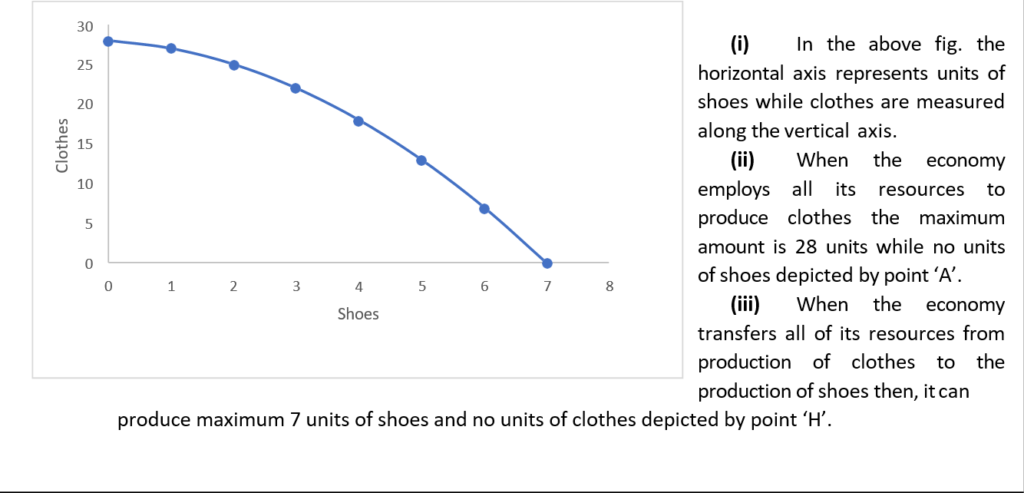
- Similarly, the economy produces various combination of these two goods like B, C, D, E, F, G.
- By joining all these points, we get a downward sloping PPF curve.
Characteristics of PPF
- PPF slopes downwards: PPF shows the various feasible combination of two goods that can be produce with the help of available resources and technology. As the amount of resources and the level of technology are assumed to be constant more production of one good is only possible by taking away resources from the production of another good. So, it establishes an inverse relationship between change in quantity of one commodity and change in quantity of the other commodity, therefore PPF slopes downwards.
- PPF is concave to the origin: PPF is concave to the origin because of increasing MOC or MRT. The marginal opportunity cost means that for additional unit of a good, the sacrifice of units of other good goes on increasing. Since the sacrifice of units of other good goes on decreasing, production possibilities would be concave to the origin. This behavior assumes that all resources are not equally efficient in production of all goods. As more of one good is produced, less efficient resources have to be transferred to the production of the other good which raises marginal cost i.e., marginal rate of transformation (MRT).
MRT always increases
The rise in MRT occurs when resources that are specialized or more adopted for the production of a particular good (say clothes), are transferred to the production of another good (say shoes), for which they are less productive or less specialized. So, the transfer of resources from more productive to less productive uses directly implies a fall in their productivity, which requires more sacrifice of resources to produce an additional unit of the other commodity. And hence MRT increases.
Different shapes of PPF
- Convex to the origin: As the slope of PPF is depends on the behavior of MRT. So, in case when MRT is decreasing the PPF will be convex to the origin i.e., less and less resources are sacrificed to gain an additional unit of another commodity.
As shown in given fig.
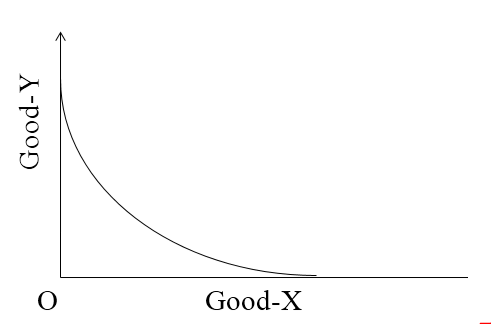
- Straight line PPF: If the economy assumes MRT to be constant i.e., same amount of resources is sacrificed to gain an additional unit of another commodity.
As shown in given fig.
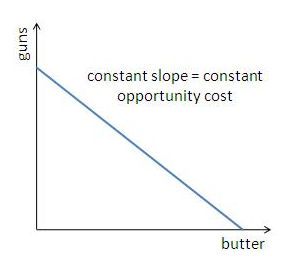
Attainable and Unattainable combinations
- Attainable combinations: All those combination at which economy can operate are known as attainable combinations. There can be two possibilities of attainable combinations.
- Optimum utilization of resources: If the economy utilizes its resources fully and efficiently then it will operate at combination like A, B, C, D, E, F, G and H on PPF.

Underutilization of resources: Sometimes the economy fails to utilize its resources most efficiently or they produce less according to their capacity. So, in the case when resources are waste or remained underutilized then, the economy will operate at any point inside the PPF like ‘I’.

Unattainable combinations: With the given amount of resources, the economy can produce a feasible amount of goods that means the economy can’t produce beyond the fuller utilization possibilities like ‘J’.

Change in PPF
PPF is made on the assumption of constant resources and a fixed level of technology. However, the real world shows dynamicity it means resources and technology change with time thereby causes a change in PPF accordingly.
There can be two ways by which PPF changes
- Shift in PPF: Whenever there is a change in technology, or economic fluctuations the PPF would expect to be shift either outwards (rightwards) or inwards (leftwards).
- Outward (Rightward) shift in PPF: An outward shift of PPF means that an economy has increased its production potential to produce all goods i.e., consumer goods or capital goods, war goods or civil goods. This can occur due to following reasons:
- Advancement in Technology.
- Increase in labour force.
- Inflow of foreign capital etc.
- Outward (Rightward) shift in PPF: An outward shift of PPF means that an economy has increased its production potential to produce all goods i.e., consumer goods or capital goods, war goods or civil goods. This can occur due to following reasons:
In all of the above cases ‘PPF’ would undergo a rightward shift from ‘AH’ to A1H1. As shown in fig.

2. Inward (leftward) shift in PPF: An inward shift of PPF means that an economy has suffered a loss or exhaustion of some of its scarce resources thereby reduces the potential to produce all goods i.e., consumer goods or capital goods, war goods, or civil goods. This can occur due to the following reason:
- Depletion of Natural resources
- Outflow of Capital
- Natural disaster etc.
In all of the above cases ‘PPF’ would undergo the leftward shift from ‘AH’ from A0H0. As shown in fig.

- Rotation in PPF: Sometimes economies undergo to a situation when there is change in production technique of only one commodity while production of other good remains constant. It may occur in following ways:
- Rotation towards X-axis: When there is a technological upgradation/degradation it is meant for the production of only one good or resources have increased/decreased for the production of one commodity (say X) only. In that scenario PPF will rotate inward or outward towards X only. As shown is fig. It will rotate outward from ‘AH’ to ‘AH1’ and inward to ‘AH0’ when resources increase or decrease respectively.
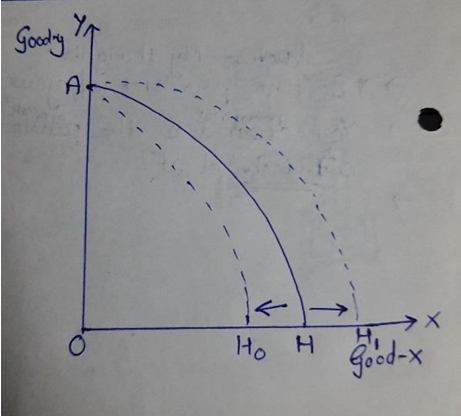
Rotation towards Y-axis: When there is a technological up-gradation/degradation it is meant for the production of only one good or resources have increased/decreased for the production of one commodity (say Y) only. In that scenario, PPF will rotate inward or outward towards Y only. As shown in fig. It will rotate outward from ‘AH’ to ‘A1H’ and inward to ‘A0H’ when resources increase or decrease respectively.
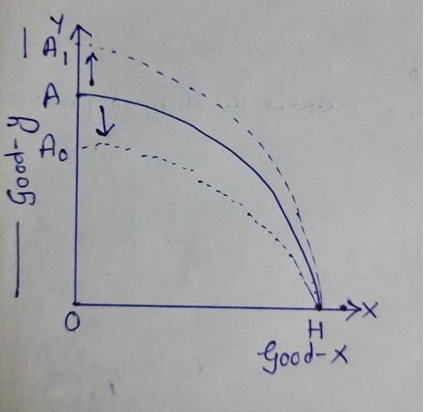
Overview of PPF:
Let us understand the whole concept of PPF with the help of the given fig.
- PPF shows the maximum amount of two goods that can be produced with the full and efficient utilization of available of resources like any combination from A to H.
- As resources and level of technology are assumed to be fixed more of one commodity can only be produced by transferring resources from one to the another which makes it ‘downward sloping’.
- PPF is concave to the origin due to increasing MRT.
- PPF shows the ability of the economy to produce various combination of two goods but the actual production depends on how well economy uses its scarce resources.
- If the economy produces at any point inside the PPF like ‘I’ it means resources are not utilised fully and efficiently.
- Any point inside or on PPF is known as ‘Attainable combinations’ like A to H or I.
- Any point outside PPF like ‘J’ shows ‘Unattainable combination’ or ‘Growth of resources’.
- If there is technological innovation or growth of resources PPF ‘AH’ shifts rightward from ‘AH’ to A1H1.
- If there is technological degradation or depletion of resources PPF ‘AH’ shifts leftward from ‘AH’ to A0H0.
